Acute rhinosinusitis in childhood - a new solution to an old problem
DOI:
https://doi.org/10.15574/SP.2024.138.25Keywords:
acute rhinosinusitis, post-viral rhinosinusitis, treatment, children, Sinudafen, SparklinAbstract
Acute inflammation of the mucous membrane of the nose and paranasal sinuses (acute rhinosinusitis (ARS)) is a fairly common pathology in pediatrics and otorhinolaryngology.
The aim of the research was to improve the effectiveness of treatment children with ARS by introducing a combination complex of natural plant extracts "Sinudafen" and effervescent isotonic seawater solution "Sparklin" and to investigate the effect of the proposed complex treatment on the frequency of repeated ARS.
Materials and methods. The study was conducted between February and December 2023 in two independent centers. The study included 98 patients with signs of ARS. The Main group - 67 patients who received "Sinudafen" and "Sparklin" for 10-14 days, symptomatic and/or etiotropic therapy if necessary. The Control group - 31 patients who received standard therapy.
The results. The examination carried out on the 14th day showed that, compared to standard treatment, the patients of the Main group had a statistically significantly lower risk of maintaining such local symptoms of ARS (edema of the mucous membrane and mucous secretions from the nose). With the faster rates of recovery of children in the Main group, the pharmacological load on patients decreased significantly. The use of "Sinudafen" and "Sparklin" in comparison reduced the need to prescribe antibacterial and antiseptic drugs in the acute period. Better clinical dynamics was accompanied by a reduction in the length of hospitalization, the use of "Sinudafen" + "Sparklin" increased the chances of reducing the duration of the acute period within ≤4 days.
Conclusions. The use of "Sinudafen" and "Sparklin" complex in the treatment of children with ARS allows for a 3.8-fold increase in the chances of recovery within ≤4 days. The proposed complex treatment reduces the need for antibiotics/anesthetics by 15.8 times and reduces the risk of repeated episodes of ARS by 18.2 times during the 6-month follow-up period. The use of "Sinudafen" with "Sparklin" is characterized by good tolerability, absence of side effects, high adherence, and also reduces the cost of treatment of one episode of ARS by 50%.
The research was carried out in accordance with the principles of the Helsinki Declaration. The study protocol was approved by the Local Ethics Committee of the participating institution. The informed consent of the patient was obtained for conducting the studies.
No conflict of interests was declared by the authors.
References
Bachert C, Hormann K, Mosges R et al. (2003). An update on the diagnosis and treatment of sinusitis and nasal polyposis. Allergy. 58: 176-191. https://doi.org/10.1034/j.1398-9995.2003.02172.x; PMid:12653791
Chow AW, Benninger MS, Brook I, Brozek JL, Goldstein EJ, Hicks LA et al. (2012, Apr). IDSA clinical practice guideline for acute bacterial rhinosinusitis in children and adults. Clin. Infect. Dis. 54(8): e72-e112. https://doi.org/10.1093/cid/cis370
De Aquino Souza Miskinis R, do Nascimento LÁ, Colussi R. (2023, Mar 15). Bioactive compounds from acerola pomace: A review. Food Chem. 404; Pt A: 134613. Epub 2022 Oct 17. https://doi.org/10.1016/j.foodchem.2022.134613; PMid:36444022
Fokkens W, Lund V, Hopkins C et al. (2020). European Position Paper on Rhinosinusitis and Nasal Polyps. Rhinology Supplement 29: 1-464.
Fokkens WJ, Lund VJ, Mullol J, Bachert C, Alobid I, Baroody F et al. (2012, Mar). EPOS 2012: European position paper on rhinosinusitis and nasalpolyps 2012. A summary for otorhinolaryngologists. Rhinology. 50(1): 1-12. https://doi.org/10.4193/Rhino12.000; PMid:22469599
Greenberg RS, Daniels SR, Flandersetal WD. (2004). Medical Epidemiology. 4th edition. Norwalk, CT: Appleton&Lange: 196.
Hoffmans R, Wagemakers A, van Drunen C, Hellings P, Fokkens W. (2018). Acute and chronic rhinosinusitis and allergic rhinitis in relation to comorbidity, ethnicity and environment. PLoSOne. 13: e0192330. https://doi.org/10.1371/journal.pone.0192330; PMid:29401486 PMCid:PMC5798836
Intharuksa A, Arunotayanun W, Yooin W, Sirisa-Ard P. (2022, Jul 13). A Comprehensive Review of Andrographispaniculata (Burm. f.) Nees and Its Constituents as Potential Lead Compounds for COVID-19 Drug Discovery. Molecules. 27(14): 4479. https://doi.org/10.3390/molecules27144479; PMid:35889352 PMCid:PMC9316804
Leung R, Almassian S, Kern R, Conley D, Tan B, Chandra R. (2013). Patient level decision making in recurrent acute rhinosinusitis: a cost benefit threshold for surgery. Laryngoscope. 123: 11-16. https://doi.org/10.1002/lary.23504; PMid:22952090
Lin SW, Wang YH, Lee MY, Ku MS, Sun HL et al. (2012, Jan). Clinical spectrum of acute rhinosinusitis among atopic and nonatopic children in Taiwan. Int J Pediatr Otorhinolaryngol. 76(1): 70-75. Epub 2011 Nov 1. https://doi.org/10.1016/j.ijporl.2011.10.002; PMid:22051141
Orlandi RR, Kingdom TT, Hwang PH et al. (2016). International Consensus Statement on Allergy and Rhinology: Rhinosinusitis. Int Forum Allergy Rhinol. 6; Suppl 1: S22-S209. https://doi.org/10.1002/alr.21694; PMid:26878819
Rosenfeld RM, Piccirillo JF, Chandrasekhar SS et al. (2015). Clinical practice guideline (update): Adult sinusitis. Otolaryngology - Head and Neck Surgery (United States). 152: S1-S39. https://doi.org/10.1177/0194599815572097; PMid:25832968
Stenner M, Rudack C. (2014, Dec 1). Diseases of the nose and paranasal sinuses in child. GMS Curr Top Otorhinolaryngol Head Neck Surg. 13: Doc10. doi: 10.3205/cto000113. PMID: 25587370; PMCID: PMC4273171.
Yurochko F, Kosakovskyi A, Shkorbotuna V ta insh. (2020). Dytiacha rynolohiia. Navch.-metod. posibnyk. Pid red. F. Yurochka, A. Kosakovskoho, V. Shkorbotuna. Lviv: Ms: 288., il.
Downloads
Published
Issue
Section
License
Copyright (c) 2024 Modern pediatrics. Ukraine

This work is licensed under a Creative Commons Attribution-NonCommercial 4.0 International License.
The policy of the Journal “MODERN PEDIATRICS. UKRAINE” is compatible with the vast majority of funders' of open access and self-archiving policies. The journal provides immediate open access route being convinced that everyone – not only scientists - can benefit from research results, and publishes articles exclusively under open access distribution, with a Creative Commons Attribution-Noncommercial 4.0 international license (СС BY-NC).
Authors transfer the copyright to the Journal “MODERN PEDIATRICS. UKRAINE” when the manuscript is accepted for publication. Authors declare that this manuscript has not been published nor is under simultaneous consideration for publication elsewhere. After publication, the articles become freely available on-line to the public.
Readers have the right to use, distribute, and reproduce articles in any medium, provided the articles and the journal are properly cited.
The use of published materials for commercial purposes is strongly prohibited.

